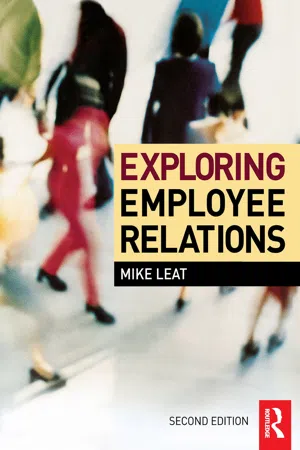
- 464 pages
- English
- ePUB (mobile friendly)
- Available on iOS & Android
Exploring Employee Relations
About This Book
Exploring Employee Relations is a straightforward and accessible text that is aimed at students who are taking the subject for the first time. The structure is clear and logical, leading the newcomer through the topics in a way to maximise comprehension. Key issues are highlighted and supported by a small case or example from business. Chapters are structured to enable progressive learning with a logical development of the content. Each chapter ends with a summary of the key points met in the text and these are further reinforced by review and discussion questions, with answers and feedback on the activities included at the end of the book. The chapters are grouped thematically into parts and longer case studies are included that are suitable for assignment and seminar work. This new edition is thoroughly revised with a new international approach which provides new material on the European Union and the role of Government and Demography, bargaining power and securing employee commitment. The text has also been written to cover the new CIPD employee relations syllabus
Frequently asked questions
Part One Introduction
Chapter 1 Employee relations and the employment relationship
- Introduction
- Definitions of employee relations
- The employment relationship
- A psychological contract: interests and expectations
- Forms of attachment, compliance and commitment
- Compliance
- Commitment
- Conflict, cooperation and perspectives
- Unitarism
- Pluralism
- Radical/Marxist
- The balance of bargaining power
- A legal contract and the relevance of ideology
- The quality of employee relations
- Unitarist
- Pluralist
- Radical/Marxist
- An industrial relations system
- Outputs
- Inputs
- Processes
- Criticisms of the Dunlop model
- A framework for studying employee relations
- Summary
- References
Introduction
Learning objectives
- Discuss the main differences of view as to the subject matter of both employee and industrial relations and the differences between them.
- Identify the relevance of contexts to the employment relationship.
- Explain the concept and relevance of a psychological contract.
- Analyse the employment relationship in terms of the form of power available to employers and the nature of employee involvement.
- Examine the nature of the employment relationship in terms of compliance or commitment.
- Distinguish between the notions of employee involvement and commitment.
- Demonstrate the significance of perspective to our understanding of the employment relationship.
- Decide whether you think the employment relationship is essentially a conflictual one.
- Examine the meaning of quality in employee relations and explain the relevance of perspective.
- Discuss the appropriateness of the many possible indicators of the quality of employee relations and the relevance of perspective.
- Critically examine the notion of an industrial relations system.
Definitions of employee relations
- became inevitably associated with trade unions, collective bargaining and industrial action;
- had too strong a tendency to view the world of work as synonymous with the heavy extractive and manufacturing sectors of employment, sectors which were dominated by male manual workers working full-time and which are in decline in nearly all developed economies.
- encompass the now dominant service sector which, in many developed countries, now employs more than 70 per cent of the workforce, and the changes in the composition of the labour force such as more women working and more part-time, temporary and fixed-term contracts;
- include non-union as well as union scenarios and relationships.
- Usage, fashion and slippage.
- It is increasingly used by personnel practitioners to describe that part of personnel and development concerned with the regulation of relations (collective and individual) between employer and employee.
- There are actual and real differences of focus, with employee relations tending to focus upon management and management issues alone and on contemporary rather than historical practices; the way things are as opposed to the way things were.
Employee relations is a study of the rules, regulations and agreements by which employees are managed both as individuals and as a collective group, the priority given to the individual as opposed to the collective relationship varying from company to company depending upon the values of management. As such it is concerned with how to gain people's commitment to the achievement of an organization's business goals and objectives in a number of different situations …
The employment relationship
A psychological contract: interests and expectations
- that employees will be treated fairly and honestly;
- that the relationship should be characterized by a concern for equity and justice and that this would require the communication of sufficient information about changes and developments;
- that employee loyalty to the employer would be reciprocated with a degree of employment and job security;
- that employees’ input would be recognized and valued by the employer.
Table of contents
- Cover Page
- Half-Title Page
- Title Page
- Copyright Page
- Table of Contents
- Preface
- Part One Introduction
- Part Two The Global Context
- Part Three The National Context
- Part Four Organizational Context: Processes, Policies and Procedures
- Bibliography
- Index